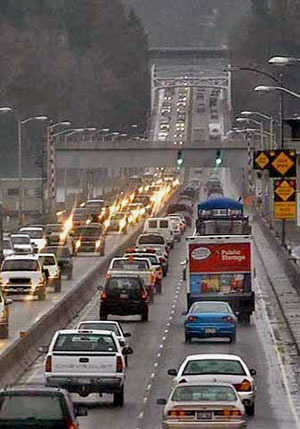Journal of Public Transportation, Vol. 9, No. 5, 2006 9/8/06 30 and 8 minutes on the Northwest Freeway. The average time spent waiting for a bus was assumed to be half of the average headway based on the assumption of random arrivals of transit passengers (Meyer and Miller 2001). Casual carpoolers saved an average of 2 minutes 36 seconds over transit on the Katy Freeway and 1 minute 36 seconds on the Northwest Freeway. Other factors besides travel time savings might have influenced the mode choice of the travelers. Monetary costs (e.g., transit fare, fuel) or trip purpose could have affected a traveler's decision (Wall 2002). Socioeconomic characteristics could also have had a major influence on a traveler's decision to casual carpool. Travelers may have valued the reliability of travel times on the HOV lane. The survey data were used to determine what, if any, trip and socioeconomic characteristics increased the likelihood of a traveler choosing to casual carpool on a frequent (3 or more times per week) basis. Comparison of Traveler Characteristics by Mode The survey data were initially examined for significant differences (p ≤ 0.05) among four groups of travelers based on their primary mode choice: driving on main lanes, using HOV lane with a traditional carpool, casual carpooling, and tran- sit. A Chi-Square test assessed significant differences among the binary variables, and a one-way analysis of variance (ANOVA) examined the continuous variables. Additionally, a Kruskal-Wallis test determined any significant difference between groups for the ordinal variables of age, income, and education. The results of the statistical tests revealed significant differences among travelers in the four primary morning modes of travel (Table 2). The percentage of respon- dents on commute, recreation, school, and other trip types was significantly differ- ent among the four groups. Casual carpoolers were more likely to be on commute trips. The percentage of respondents ages 25 to 34 and 65+ was significantly differ- ent among modes. A much higher percentage of casual carpoolers were between ages 25 and 34. The average household size, percentage of single adult house- holds and married without children households, and the number of vehicles per household also differed among modes, with HOV users having significantly larger households. A difference was also found for those with occupations that were pro- fessional/managerial, sales, homemaker, self-employed, or retired. Income ranges of $25,000 to $35,000, $50,000 to $75,000, $100,000 to $200,000, and $200,000 or more were also different among the four mode choices. Page 9 Slugging in Houston 31 Table 2. Descriptive Statistics of Surveyed Travelers 1 Significant (p ≤ 0.05) difference when comparing all four modes. 2 Significant (p ≤ 0.05) difference when comparing casual carpooling and transit. Page 10 Journal of Public Transportation, Vol. 9, No. 5, 2006 32 Next, similar statistical tests were performed to determine significant differences (p ≤ 0.05) between travelers using just two mode choices: casual carpooling and transit. These mode choices were specifically examined due to their symbiotic relationship and the similarity of the modes since travelers on both modes (1) use park-and-ride lots, (2) have someone else drive, (3) travel on HOV lanes, and (4) are dropped off relatively close to their work. Also, casual carpoolers are often former transit users (Beroldo 1990), and in this study more than 90 percent still used transit for some of their similar trips (Table 3). The results of the statistical tests (Table 2) revealed several significant differ- ences between casual carpoolers and transit riders. A higher percentage of casual carpool passengers were on commute trips and between the ages of 25 and 34, while a higher percentage of transit riders were between the ages of 55 and 64. A significantly higher percentage of casual carpoolers had professional/managerial occupations, while a significantly higher percentage of transit riders had house- hold incomes between $25,000 and $34,999. Casual Carpool Passenger Characteristics The surveys distributed to casual carpool passengers contained a series of ques- tions that were exclusive to that group. These questions addressed the nature of each traveler's casual carpooling trip and his or her previous experience using the mode (Table 3). For this analysis only, both frequent and infrequent casual carpoolers were examined. The results provided insight into the practice of casual carpooling in Houston, including what modes were commonly used for return trips and how frequently respondents joined a casual carpool. Survey responses indicated that most casual carpool passengers (65.3%) had never met their travel companions before. However, almost one third indicated that they had traveled with them once or twice, indicating that a relatively small community of people used the mode consistently. More than 75 percent of users noted that they casual carpooled at least three times per week. Passengers also cited saving money (62.8%) and slow bus service (52.6%) as the two primary rea- sons for casual carpooling. They indicated that they often use the bus for similar trips and for the evening return trip. They also noted that money is rarely given to the driver as compensation, which is consistent with casual carpooling practices elsewhere in the United States. Page 11 Slugging in Houston 33 Table 3. Casual Carpool Passenger Characteristics (n = 208) Note: Some percentages sum to over 100 percent as respondents could choose multiple answers for some questions Page 12 Journal of Public Transportation, Vol. 9, No. 5, 2006 34 Mode Choice Model Estimation To better understand casual carpoolers and the factors that affect their mode choice, discrete choice model coefficients were estimated for two sets of choices. The choice between casual carpooling and transit was evaluated with the first model. The second model examined traveler choice of four modes: casual carpool, transit, traditional carpool, and driving on GPLs. Methodology Both models were estimated as discrete choice models. Discrete choice models assume that each traveler makes his or her decision based on the utility of each mode (Ben-Akiva and Lerman 1985). The traveler's ultimate decision will deter- mined by both the systematic utility based on measured variables and the random utility of each mode. The model in this analysis was estimated using a logit model, which assumes that random utilities follow an extreme value distribution (Small and Winston 1999). Casual Carpool versus Transit Mode Choice Model Although many variables were tested when estimating the model coefficients, only those variables significant at the 95 percent confidence level and not correlated to other variables were left in the final model. The results of the discrete choice model are shown in Table 4. For this model, the null choice was casual carpooling. The utility function derived in the model describes the utility of the transit mode relative to the casual carpooling mode that had all coefficients equal to zero. The results of the model highlight some of the factors that describe selected types of travelers who choose to casual carpool rather than use transit. The constant coefficient is positive, indicating that all else being equal, travelers were more likely to choose transit than casual carpooling. This was not surprising as many more travelers used transit than casual carpools. The results also indicated that having an income between $25,000 and $35,000 increased the traveler's likelihood to use transit rather than casual carpooling. However, being on a commute trip, making a higher number of total trips per week, and/or being between the ages of 25 and 34 increased the traveler's likelihood of forming casual carpools. Page 13 Slugging in Houston 35 Table 4. Model Coefficient Estimation Results (Casual Carpooling vs. Transit) 1 1 Base alternative is casual carpooling with utility of zero. *Significant at the 95 percent confidence level. Four-Option Mode Choice Model Several sets of variables were used for testing the four-choice model, using the main lanes option as the null choice. Only variables significant at the 95 percent confidence level remained in the final model. The variables used in the model as well as which mode choice utility functions they were associated with are listed in Table 5, while the model estimation results are shown in Table 6. The constants for the HOV, casual carpool, and transit modes were all negative, indicating that all else being equal, travelers were most likely to drive on the main lanes. The trip purpose, age, and occupation (professional) variables applied only to the casual carpooling utility function and indicated a number of factors influ- enced casual carpoolers' decisions. The coefficient for the trip purpose was positive, indicating that being on a commute trip increased the likelihood that a traveler Page 14 Journal of Public Transportation, Vol. 9, No. 5, 2006 36 Table 5. Definitions of Variables Used in Logit Model (All Four Modes) would choose casual carpooling over the other three modes, which duplicates the results of the previous model. Professional/managerial or administrative/clerical occupations also increased a traveler's likelihood to use casual carpooling over the other three modes. Thus, travelers with weekday jobs with typical workday hours were more likely to casual carpool. This was not surprising considering the times during which casual carpooling occurs. Travelers with typical workdays would be more likely to encounter peak-period congestion if they drove alone on the GPLs. The results also indicated being between the ages of 55 and 64 reduced a traveler's likelihood of casual carpooling, which reflected a possible increased willingness among younger persons to try a newer, less-utilized mode of transportation. In addition, having an income between $25,000 and $35,000 reduced a traveler's likelihood of casual carpooling, which was surprising considering the relatively low expense of that mode. One possible explanation was that low-income persons already used transit for many of their other trips, and they chose to use transit Page 15 Slugging in Houston 37 Table 6. Model Coefficient Estimation Results (All Four Modes) 1 Base alternative is driving alone on main lanes with utility of zero. *Significant at the 95 percent confidence level. Page 16 Journal of Public Transportation, Vol. 9, No. 5, 2006 38 during the times of casual carpooling as well. Another possible explanation was subsidized transit passes were available to low-income travelers. Travelers with subsidized transit passes would have little to no money-savings incentive to casual carpool. Also, the descriptive statistics indicated that travelers with incomes between $25,000 and $35,000 were less likely to make commute trips, leading to less use of casual carpooling because commuting is a primary factor that influ- ences casual carpool use. Summary This research effort examined the use of casual carpooling in Houston, Texas. Sur- vey results revealed that most casual carpool passengers often used transit for eve- ning return trips and similar morning trips. Approximately 63 percent used casual carpooling to save money and about 53 percent used casual carpooling because of slow bus service. Most casual carpoolers (76%) used this mode three or more times per week. Casual carpool passengers were significantly more likely to be on com- mute trips and be between the ages of 25 and 34 (younger), but were significantly less likely to have household incomes between $25,000 and $35,000. The results obtained in these analyses provided some information on the charac- teristics of travelers who chose to casual carpool. This information can be used to better evaluate HOV/HOT lane use and future lane development considerations. Casual carpooling has grown in popularity and should be considered when assess- ing potential corridor improvements. Although potential liability concerns would likely prevent agencies from actively promoting casual carpooling, they could encourage it passively by constructing park-and-ride HOV facilities that are con- ducive to the mode. Casual carpooling has the potential to improve the operation efficiency of HOV/HOT facilities by improving person movement. Although there are potential liability concerns, it may eventually become beneficial to promote casual carpooling as a viable mode alternative. Acknowledgments This article reflects the views of the authors, who are responsible for the facts and the accuracy of the data presented herein. This article was a result of research conducted in cooperation with the Federal Highway Administration (FHWA), the Texas Department of Transportation (TxDOT), and the Metropolitan Transit Authority of Harris County, Texas. The authors gratefully acknowledge the con- 39 tributions of numerous individuals and organizations that made the successful completion of this article possible. References Ben-Akiva, M., and S. Lerman. 1985. Discrete choice analysis: Theory and application to travel demand. Cambridge, MA: MIT Press. Beroldo, S. 1990. Casual carpooling in the San Francisco Bay Area. Transportation Quarterly 44 (1): 133–150. Burris, M., and J. Appiah. 2004. An examination of Houston's QuickRide partici- pants by frequency of QuickRide usage. Transportation Research Record 1864, 22–30. Burris, M., and W. Stockton. 2004. HOT lanes in Houston—Six years of experience. Journal of Public Transportation 7 (3): 1–21. Houston TranStar Real Time Traffic Information. http://traffic.tamu.edu. Accessed June 15, 2004. LeBlanc, D. E. 1999. Slugging: The commuting alternative for Washington, D.C. East Point, GA: Forel Publishing. Meyer, D., and E. Miller. 2001. Urban transportation planning. New York: McGraw- Hill. Ojah, M., and M. Burris. 2004. Quantification of casual carpooling in Houston. Texas Transportation Institute. Reno, A.T., W. A. Gellert, and A. Verzosa. 1989. Evaluation of Springfield instant carpooling. Transportation Research Record 1212, 53–62. RIDES for Bay Area Commuters, Inc. 1999. Casual carpooling 1998 update. rideshare.511.org/research/pdfs/casualcarpool.99.pdf> Accessed December 8, 2003. Small, K. A., and C. Winston. 1999. The demand for transportation: Models and applications. Essays in Transportation Economics and Policy. Washington, DC: Brookings Institute Press. Spielberg, F., and P. Shapiro. 2000. Mating habits of slugs: Dynamic carpool forma- tion in the I-95/I-395 corridor of Northern Virginia. Transportation Research Record 1711, 31–38. Page 18 Journal of Public Transportation, Vol. 9, No. 5, 2006
The phrase,'Unsound Transit', was coined by the Wall Street Journal to describe Seattle where,"Light Rail Madness eats billions that could otherwise be devoted to truly efficient transportation technologies." The Puget Sound's traffic congestion is a growing cancer on the region's prosperity. This website, captures news and expert opinion about ways to address the crisis. This is not a blog, but a knowledge base, which collects the best articles and presents them in a searchable format. My goal is to arm residents with knowledge so they can champion fact-based, rather than emotional, solutions.
Transportation
Monday, March 10, 2008
Slugging in Houston
The articles are posted solely for educational purposes to raise awareness of transportation issues. I claim no authorship, nor do I profit from this website. Where known, all original authors and/or source publisher have been noted in the post. As this is a knowledge base, rather than a blog, I have reproduced the articles in full to allow for complete reader understanding and allow for comprehensive text searching...see custom google search engine at the top of the page. If you have concerns about the inclusion of a specific article, please email bbdc1@live.com. for a speedy resolution.









